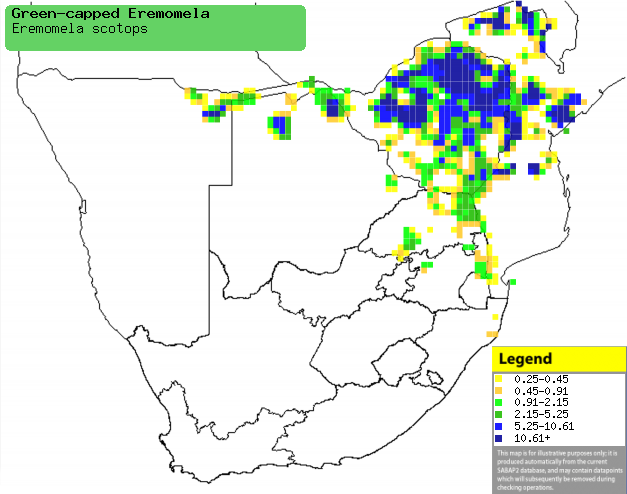|
Eremomela scotops (Green-capped
eremomela)
Donkerwangbossanger [Afrikaans]; Niini (generic term for
warblers and eremomelas) [Kwangali]; Timba (generic name for cisticolas
and warblers) [Shona]; Groenkap-eremomela [Dutch]; Érémomèle à calotte
verte [French]; Grünkappen-eremomela [German]; Eremomela-de-barrete-verde
[Portuguese]
Life
> Eukaryotes >
Opisthokonta
> Metazoa (animals) >
Bilateria >
Deuterostomia > Chordata >
Craniata > Vertebrata (vertebrates) > Gnathostomata (jawed
vertebrates) > Teleostomi (teleost fish) > Osteichthyes (bony fish) > Class:
Sarcopterygii (lobe-finned
fish) > Stegocephalia (terrestrial
vertebrates) > Tetrapoda
(four-legged vertebrates) > Reptiliomorpha > Amniota >
Reptilia (reptiles) >
Romeriida > Diapsida > Archosauromorpha > Archosauria >
Dinosauria
(dinosaurs) > Saurischia > Theropoda (bipedal predatory dinosaurs) >
Coelurosauria > Maniraptora > Aves
(birds) >
Order: Passeriformes > Family: Sylviidae
> Genus: Eromomela
Distribution and habitat
Occurs from the southern half of the DRC through Tanzania,
Angola and Zambia to southern Africa. It prefers broad-leaved woodland, such as
Miombo (Brachystegia), Burkea (Burkea africana) and Zambezi teak (Baikiaea
plurijuga), occasionally moving into gardens in south-western Zimbabwe.
|
 |
|
Distribution of Green-capped eremomela in southern
Africa, based on statistical smoothing of the records from first SA Bird
Atlas Project (©
Animal Demography unit, University of
Cape Town; smoothing by Birgit Erni and Francesca Little). Colours range
from dark blue (most common) through to yellow (least common).
See here for the latest distribution
from the SABAP2. |
Food
It prefers to forage in groups in the tree canopy, either
with other Green-capped eremomelas or other species. Its diet is not known,
other than that it eats small insects.
Breeding
- It is a facultative cooperative breeder, meaning that the breeding pair
are assisted by 1-5 helpers.
- All members participate in the construction of the nest, which is a
small cup made of plant down and buds of Miombo (Brachystegia),
secured with spider web.
- Egg-laying season in Zimbabwe is from August-February, peaking from
September-November.
- It lays 2-5 eggs, which are incubated by all group members.
Threats
Not threatened, but fragmentation of Miombo (Brachystegia)
woodland is cause for concern.
References
-
Hockey PAR, Dean WRJ and Ryan PG 2005. Roberts
- Birds of southern Africa, VIIth ed. The Trustees of the John Voelcker
Bird Book Fund, Cape Town.
-
Harrison, J.A., Allan, D.G., Underhill, L.G., Herremans, M.,
Tree. A.J., Parker, V. & Brown, C.J. (eds). 1997. The atlas of southern
African birds. Vol. 2: Passerines. BirdLife South Africa, Johannesburg.
|
